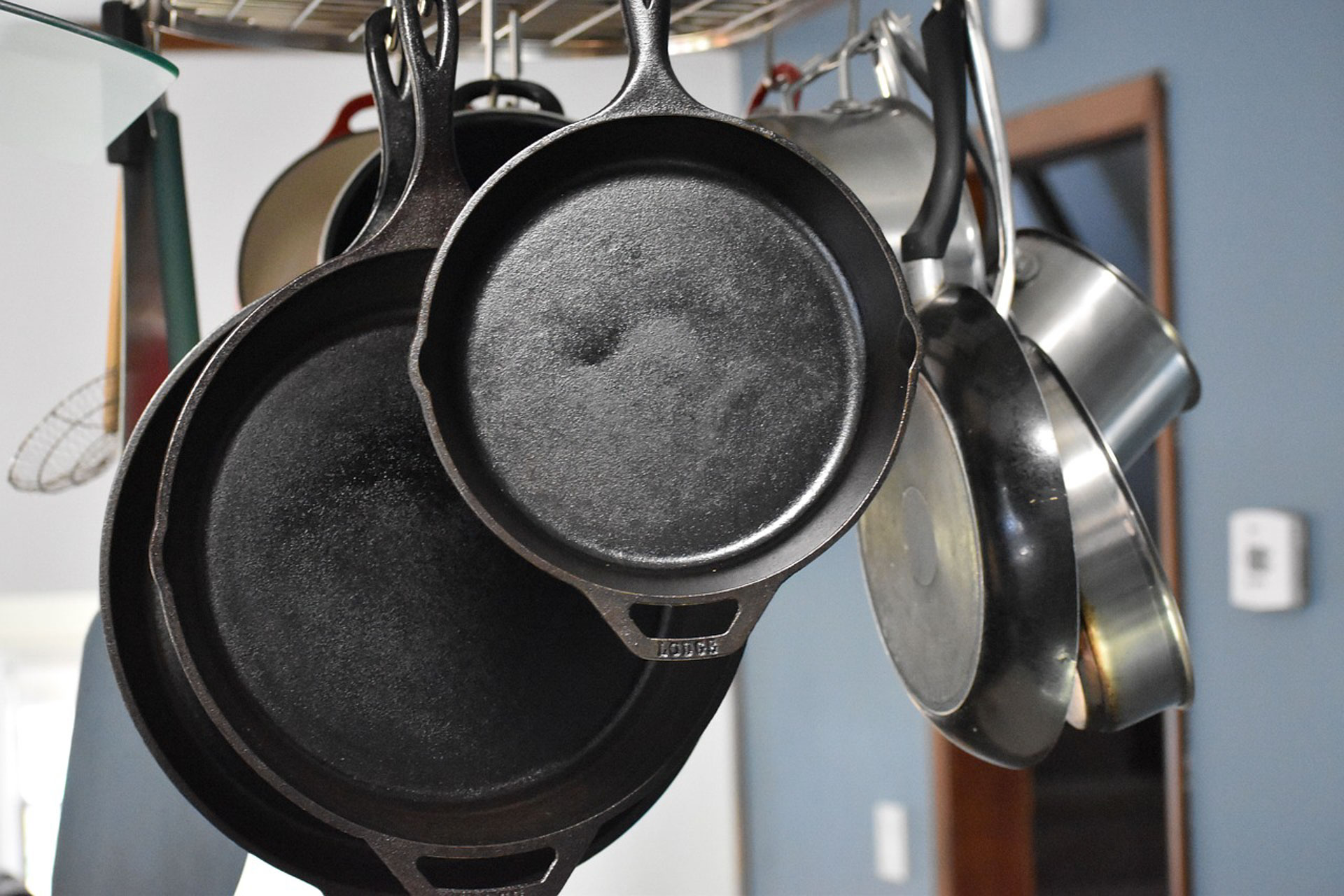Have you ever wondered what’s the main difference between a saute pan vs frying pan? If you’re cooking your own food at home, chances are, that you probably have at least one of these two pans at home already.
Using the right cookware or tools for different kinds of recipes or types of preparation plays an important role in cooking foods. The right equipment not only helps you to get the results you’re looking for, but mainly, it often simplifies the cooking process.
In this guide, we’re going to dig deep into the fundamental differences between two kitchen companions that often lead to confusion. Saute pan vs frying pan might be the question you ask yourself when buying your first kitchen basics or which pan you should use for which kind of recipe.
You’ll learn about the advantages and drawbacks between a saute pan vs frying pan, the key differences between them, and my own thoughts about how to choose the right pan for your needs.
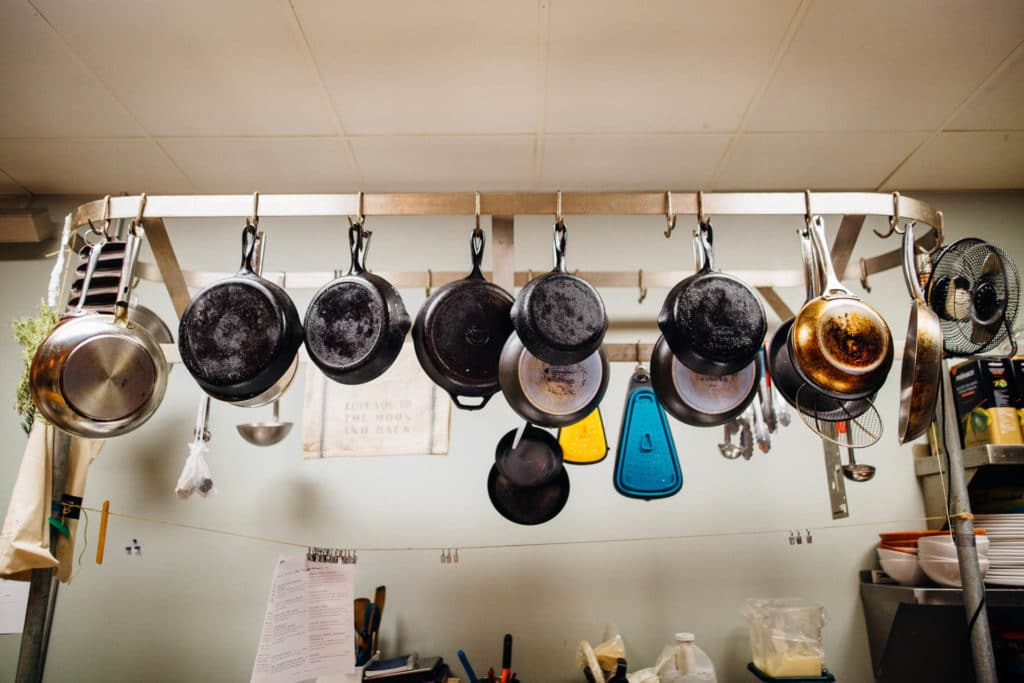
Saute pan vs Frying pan – Table of Contents
Focusing on Fry Pans / Skillets
Before we get into the details and use cases of a frying pan, there is a question that needs to be clarified first.
What’s the main difference between a frying pan and a skillet?
The terms skillet and frying pan are often used interchangeably, and mostly the same cookware is meant by the two. The difference lies in the jargon of the two terms. While in the USA or in American English, “skillet” is commonly used for a frying pan, in other parts of the world and other English-speaking countries, “frying pan” is used for the same cookware.
In the US it is also the case, that sometimes with the term “skillet” there is meant a “normal frying pan” with slightly higher and sloping sides. This often refers to cast-iron pans that are larger and have higher walls compared to a regular, shallow frying pan.
Regardless of the jargon used, both the skillet and fry pans serve the same purpose. For the sake of simplicity, I’ll assume that both frying pan and skillet mean a normal shallow pan that almost all home cooks already have at home.
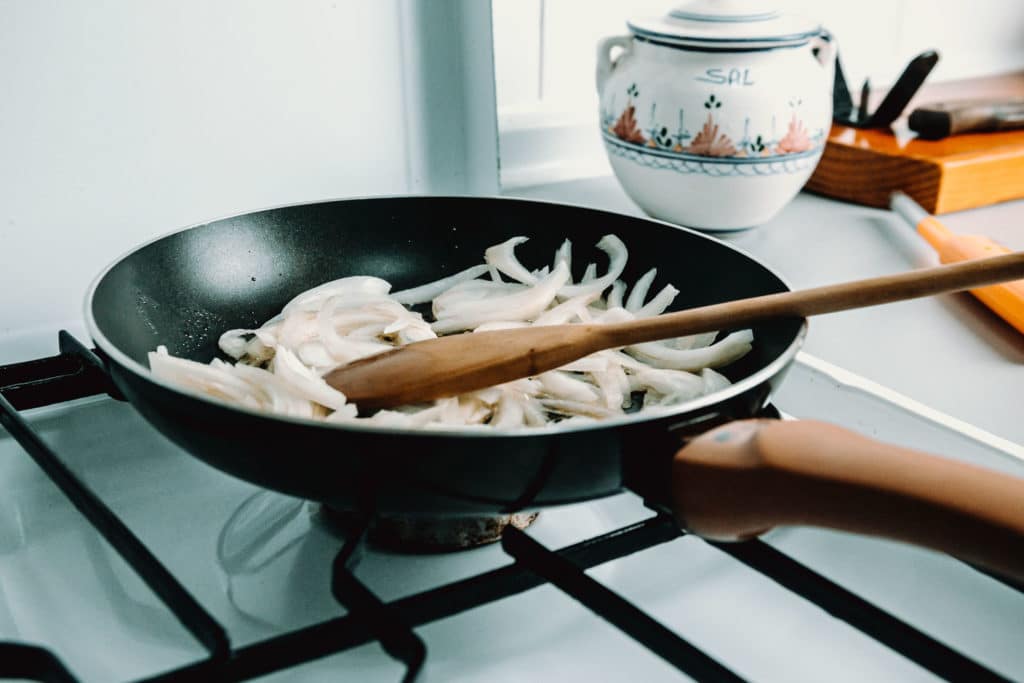
What is a frying pan/skillet used for?
A regular frying pan is one of the most basic and most used cooking equipment around the globe. The frying pan is characterized by its shallow shape, gently sloping sides, and a long handle. They come in various forms and qualities like non-stick Teflon frying pans, stainless steel, or cast-iron pans.
They all have one thing in common: Fry pans are the first choice in home kitchens when it comes to frying any kind of food. But what do they really stand out for, what are their weaknesses and when should you look for the other player in this article, the saute pan?
Key points about the skillet
In general, it is to say that frying pans are the best option for shorter cooking times. Due to its shallow pan design, the skillet is great for searing solid ingredients like meat, fish, vegetables, etc. on medium-high heat. The skillet fits best for dishes with minimal to no liquid content, like eggs, steaks, etc. Apart from that, these are a few other points that refer to a frying pan.
Lower Profile and Sloping walls
The main distinction between a saute pan vs frying pan resides in the shallow profile and the shallow, sloping sides of the former. A frying pan is a perfect joice for searing, as the moisture of the food so that the heat can escape the pan due to the sloped walls. The flared sides of the pan will help to evaporate the moisture/steam which leads to a better browning of the protein ingredient.
Absence of a lid
Generally, when you buy a frying skillet, there is no lid coming with the pan. As mentioned above, the skilled is more used for searing and shorter cooking times whereas a lid would rather counteract this kind of cooking foods, by keeping the moisture in the pan.
Sauté / flipping the food
Another important point where the skillet stands out is the ability to sauté / flip the food thanks to the sloped walls. You’re probably wondering if the word sauté doesn’t belong to the other pan type, right? This is in fact one of the most confusing terms regarding the two pans.
In French, sauté means “jumping out”, which refers to the act of flipping or tossing the food in the pan. With a sauté pan, on the other hand, flipping or “to sauté” the food in the pan is not possible due to the straight walls of the pan. This makes it quite a fun fact between these two types of pans.
Apart from that, and to come back to the point again, a frying pan is great for flipping the food in the pan. This is commonly used for rather dry frying and without having to use a spatula. Once you learn how to carefully flip food in a frying pan (without spilling everything) you’ll use that technique more and more.
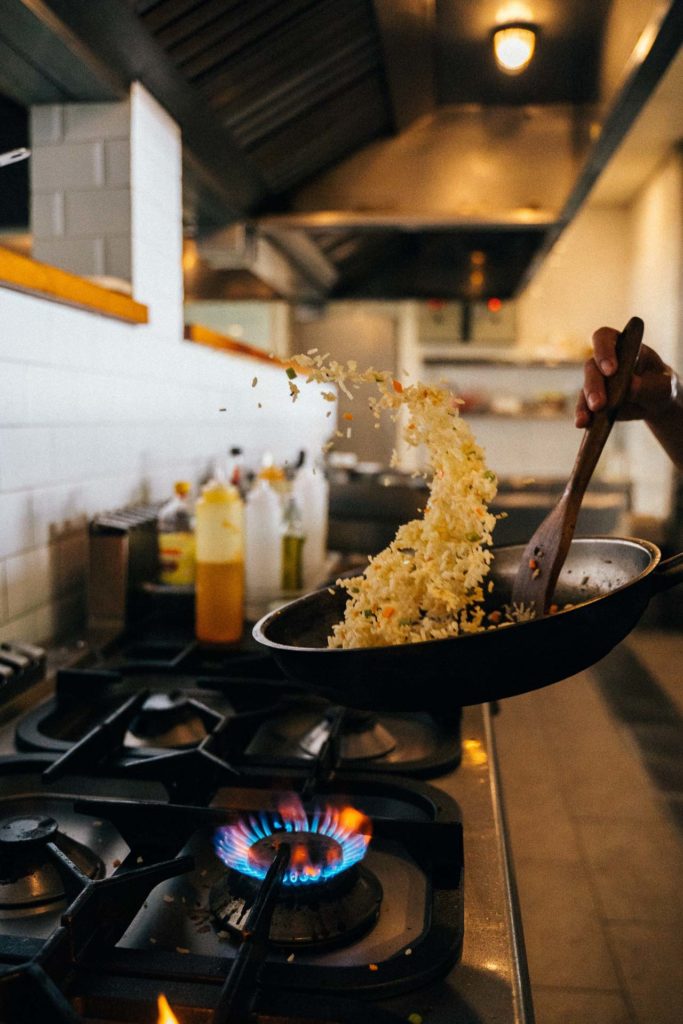
What is a saute pan used for?
Compared to fry pans, a saute pan is the better fit for longer cooking times like braising or when liquids are involved. The saute pan looks a bit like a cut-off pot with a flat bottom, a handle, and a lid. This cookware is a super versatile pan to use. Saute pans are not only larger and have a bigger inner volume, but they’re also often heavier compared to the skillet.
So, let’s talk about the key points of a saute pan, in which occasions it is the right pan to choose, and where it has similarities with the frying pan.
The larger surface area and vertical sides of the pan
A saute pan has, similar to a cooking pot, a flat bottom without sloping walls so as L-shape, straight walls. This results in a bigger volume in the pan and a larger surface area to work with. This especially comes beneficial when working with liquids or ingredients that take a lot of space in the beginning like fresh spinach for example. This is why there is often more food cooked in a saute pan compared to a skillet.
Deep frying
Due to the straight sides of the pan, a sauté pan can also used for deep frying as there is less chance of spilling the hot oil. Although, I still prefer to use larger pots as the oil doesn’t splash around as much.
Versatility
There isn’t really anything you can’t do in a saute pan that you can do in a frying pan as well, except the tossing of the food. This, in general, makes the saute a more versatile pan than the skillet. You kind of get a mix of both, a frying pan with the function of a large, half, or third-sized pot. Thanks to the large flat bottom, sauté pans are also great for flat things like pancakes, omelets, etc.
Compared to a pot, the sauté pan is still too shallow to use for things like cooking pasta, soups, or other things that need a lot of space. A regular pot or pots in different sizes are still the best choice there. But when it comes to braising, the sauté pan really shines.
Braising / dry and wet cooking
When braising, two cooking techniques come together, dry cooking so as wet cooking. You first sear the meat or vegetables on the flat and large surface of the pan and then deglaze it with liquid. The ingredients can then simmer in the pan on the stove or in the oven.
Inclusion of a lid
Saute pans also almost always come with a lid. The lid helps in the slow-cooking process to keep the moisture and heat inside the pan for a longer time. This becomes especially useful for braising as described above.

Pros and Cons between a saute pan vs frying pan
Pros of a frying pan
- lighter
- cheaper
- larger assortment
- best for searing
- tossing / sauté the food in the pan
Cons of a frying pan
- not the best when using liquids (braising or heavy sauces)
- less surface area to work with
- less versatile for different cooking methods
Pros of a saute pan
- more versatile than a skillet
- great for dry and wet cooking (braising)
- great for working with liquids and heavy sauces
- more volume and surface area to work with
- mostly comes with a lid
Cons of a saute pan
- bigger and heavier
- more expensive
- no tossing / flipping of the food (there are exceptions)
- smaller assortment
Summary
Probably to most used case for a saute pan is braising or when often cooking foods with liquids involved.
A saute pan is also great for recipes like ragout or larger amounts of sauces, where you take advantage of the large surface area of the pan and the higher sides to sear the meat or vegetables first, and then add the amount of liquid you need.
On the contrary, the frying pan might be the better choice for shorter cooking times like searing meat, fish or vegetables, eggs, or when you like the ability to sauté or toss the food in the pan.
Saute pan vs frying pan – which type of pan is the right for you?
In theory, the decision may be an easy one: Select the ideal pan for your particular cooking needs. In practice, it’s not always that easy, right?! Following, I’m covering a few different scenarios about which pan might be the right choice for you.
The right pan when you’re a beginner cook
If you are just starting to gather your first cooking equipment, a regular frying pan might be the right choice for you. A skillet is the ideal pan for most use cases, especially for simpler recipes. However, if you want just one single pan that fits almost all cooking methods in terms of versatility, a sauté pan might be the one for you.
The right pan when being on a tight budget
If you want a good quality but budget-friendly pan, the obvious choice will be a skillet. A frying pan is definitely the cheaper option and there is a larger selection of affordable pans.
The right pan for advanced chefs or lovers of Fench cuisine
If you already have a skillet or want to upgrade to expanded cooking methods, the sauté pan is the one for you. This might also be the case if you cook a lot of French recipes where braising takes a larger role.
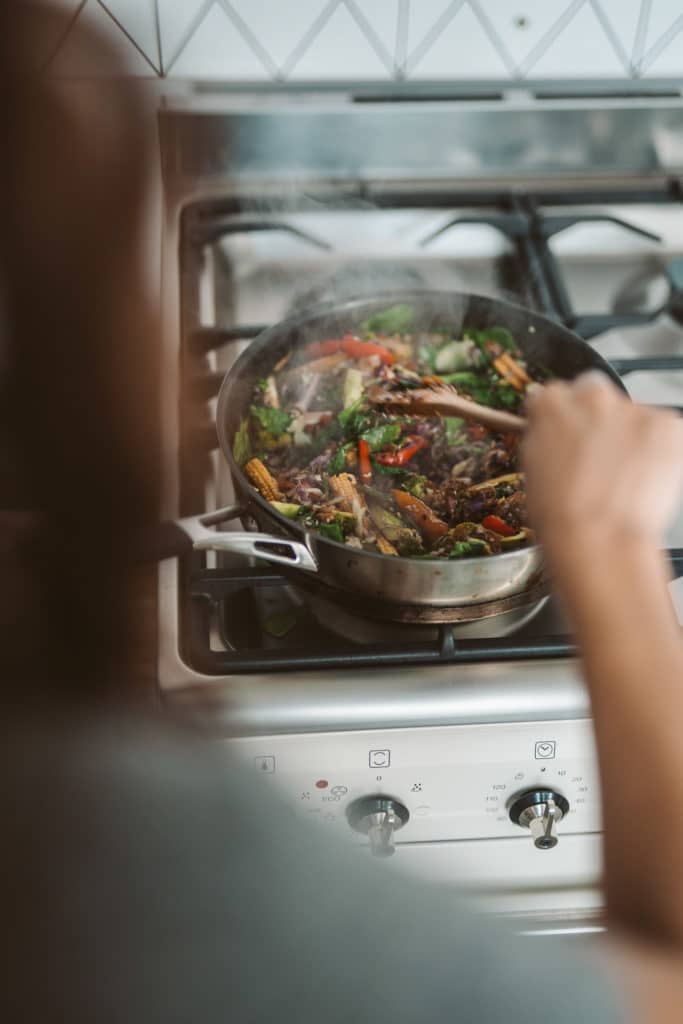
Things to consider when shopping for a saute pan vs a frying pan
Buying the right pan for each use case and deciding between the different qualities can be quite challenging these days. There are tons of pan types, a variety of materials, qualities, and sizes out there to choose from. Here are a few points that may help you with your decision.
Size of the pan
Are you someone mostly only cooking for yourself or a whole family. Also, you might just cook for 1-2 persons but cooking larger portions to have some spare food the next days. Depending the amount of food you’re going to cook, you might change the matching pan size. Also consider that you can cook smaller amounts in a bigger pan, but not the other way around. You might be cooking smaller portions 90% of the time, but if you want to keep the option for cooking guests as well, then a larger pan will be the right choice.
Different materials
Also, consider the materials of the pan that fit your needs. Here are some thoughts about that:
Non-stick pans like Teflon or ceramic
These pans are easy to cook with as you have much less chance of sticking. This makes these pans especially interesting for beginner cooks. Another benefit is the small amount of oil used for cooking as these pans don’t stick. However, a nonstick pan is not harmless in terms of health hazards, particularly if they’re not used and treated the right way. Also is a non-stick pan much less durable than the following options.
Stainless steel pans
If you invest in a stainless steel pan, or in a steel pan in general. you’ll have a peace of cooking equipment you can work with and use for a long time. Stainless steel pans are easy to clean and also look great in a kitchen. The drawbacks are, that they’re more expensive and trickier to cook with in regards to sticking. So steel pans need a little practice to work with, especially when cooking with protein-heavy food. Stainless steel is also the material the high-end and shiny sauté pans are made of as well as the popular choice of professional kitchens and professional chefs.
Cast iron skillets
The pan that survives for generations. A cast iron pan is a piece of equipment you only buy once, or even better, you inherit it from your parents/grandparents. Cast iron pans need a little more love in terms of cleaning and maintenance, but if you treat and use them right, they’re a pleasure to work with. Just thinking about high-heat searing meat, fried potatoes, or roasted vegetables, this pan is the clear winner here.
Aluminum pans
And lastly, there are aluminum pans like Italian pasta pans which are similar to a saute pan with high, vertical sides but still a little sloped edges. This helps to finish the pasta in the pan and still allows some tossing. These pans have a fast heat distribution, a great heat Conductivity and are super lightweight. In conterary, they’re not the best for browning and can bare aluminum can react with certain foods like alkaline or acidic ingredients.
Type of lid of the pan
There are lots of sauté pans coming with a glass lid. This might be the top-notch material as they should give you the benefit of seeing through and seeing what’s going inside the pan. However, in practice, glass lids tend to steam up and often you can’t really see through totally.
In addition to that, glass lids are also heavier and easier to break compared to normal stainless steel lids. So I’d rather save the weight and amount of space needed to store the lid and go for a normal stainless steel one.
Additional features
Handles
A long and sturdy handle that gives a safe hold and keeps your hands in a safe distance from the stove. Especially with a sauté pan, a helper handle on the other side of the main handle is a great plus to have. This comes in handy for safely carrying a full and heavy pan, in particular when liquids are involved.
Measurements
A lot of saute pans also already have measurements inside the pans when using liquids. This relates and is more helpful to a saute pan. The better sauté pans come with measurements inside the pan. This helps again when cooking with liquids. Firstly, to fill in the correct amount, and secondly to see by what factor the liquid has been reduced.

